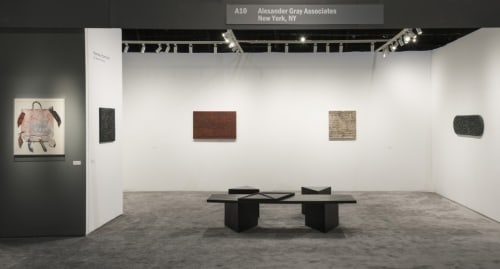
Harmony Hammond: The Weave Paintings, installation view, ADAA: The Art Show (2018)
Park Avenue Armory
Park Avenue at 67th Street, New York
Alexander Gray Associates presented a curated selection of Harmony Hammond’s “Weave
Paintings” (1973—1977), which embody an intersection of painting and sculpture that remains central to the artist’s practice to this day. With this series, Hammond broke new ground, claiming an oppositional space in process-based abstract painting at the height of second-wave feminist activism.
Harmony Hammond moved to New York City in 1969 where she, along with a group of female peers, rejected the historically male-dominated site of painting. Utilizing found fabrics, her earliest works from this period were unstretched acrylic paintings on domestic textiles such as bedspreads and curtains. These gradually developed into sculptural assemblages of painted cloth that hung on the wall or out in space. Hammond was a co-founder of A.I.R., the first women’s cooperative art gallery in New York (1972) and Heresies: A Feminist Publication on Art & Politics (1976). It was during this early period of advocacy on behalf of female artists that she consciously introduced gendered content into the painting field, with her series of weave paintings. To make these paintings on stretched canvas, Hammond applied successive layers of oil paint mixed with Dorland’s wax, incising the still wet surface with three-dimensional weave patterns that include points and burrs of paint. These pieces can appear dangerous to the viewer’s touch but are actually quite fragile. Hammond’s process of layering and marking the painted surface results in objects that reference and subvert textile traditions in craft and Modernism—from Anni Albers’ Bauhaus experiments to native North American basket-weaving. Hammond writes, “Weaving, of course, implies the grid, and the grid can suggest weaving. If you think of stitching as marking, and marking in gridded space, then before you know it, you are into pattern and decoration...I was always very interested in the notion of the stitching as a repetitive gesture - reflecting the repetition in women's lives - and a connective gesture - a means of piecing together or building ‘wholes’ out of fragments.”
Hammond’s creation of tactile surfaces in works such as Green Veil (1975) results in what she calls “fugitive” color that is fluid and difficult to place. She asserts these paintings “perform queerly” due to her utilization of mutable and inexact “near monochrome.” In her practice, abstraction does not preclude social engagement; her weave paintings epitomize an integration of political content into rigorous formal experimentation, an approach that art historian Julia Bryan-Wilson describes as “the space of the between.” This concurrent embrace and subversion of modernist traditions is apparent in her use of lozenge-shaped canvases in paintings such as Letting the Weather Get In (1977). As the artist describes, the skin-like surface “was lumpy and bumpy, irregular – presencing the body. When you’re incising into the painting surface, you’re incising into the body.... What was happening on the painting’s surface with its subtly curved edges, was mirrored in the shape.” Hammond’s recent near-monochrome canvases that are pieced, punctured, sutured, wrapped and bandaged, expand upon the incised patterned surfaces of these pioneering earlier “Weave Paintings.”
About ADAA: The Art Show
Organized annually by the Art Dealers Association of America (ADAA), The Art Show presents curated presentations by the nation’s leading fine art dealers, providing audiences a selection of works from the late 19th century through today.